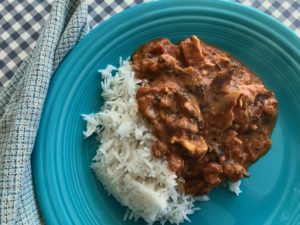Smoked fish, sweet nectarines, and savory cabbage slaw make an interesting flavor combo in these fish tacos. The first time I saw “fish tacos” on a menu, I thought it sounded disgusting. Fish? In a taco? Was this an SNL fake commercial or something, like Bass-o-matic? But then a soul braver than me ordered them, and offered me a taste. Ever since then, I’ve been trying to re-create great fish tacos at home. And I think I finally nailed it.
Parts of this recipe came from Bobbie Flay, of Food Network fame. But it’s been twisted and tweaked so it no longer resembles the original, and I can safely claim it as my own. You can certainly grill the fish, but we’re Big Green Egg disciples. My husband prefers to use his BGE smoker any time he can, as it does give meat and fish an amazingly complex flavor. But if a Webber (or other gas grill) is what you’ve got, then go for it! No harm done there.
Makes 8-10 tacos
For Cabbage Slaw
1/3 head of green cabbage, sliced thin and then chopped
6 leaves of Napa cabbage, jullienned
2-3 carrots, grated
1 sweet red pepper, diced
½ of a yellow onion, diced
½ cup diced jicama (optional)
½ cup Hellmann’s mayonnaise
2 teaspoons Penzy’s Northwoods seasoning OR 1 teaspoon sweet paprika, plus dash each salt, pepper, thyme, cracked or powdered rosemary, and garlic powder
Combine all ingredients in large bowl and stir until dressing is incorporated. Set aside or cover and chill until serving tacos.
For Nectarine Salsa
2 ripe nectarines (or peaches)
2 tablespoons minced red onion
Handful or fresh mint leaves, rinsed, and diced
Combine all ingredients in bowl and stir. If not using immediately, cover and refrigerate.
For Fish Tacos
8-10 tilapia (or other mild white fish) fillets
Vegetable oil
Lime juice
Seasonings of choice, such as Penzy’s Foxpoint seasoning (dried shallots and salt), Smoked Spanish Paprika—but even just salt and pepper would be fine.
8-10 purchased corn tortillas
Heat grill to high. Combine oil, lime juice, and seasonings in Ziplock bag and let sit for a few minutes. Place fish in an oiled grill basket or brush grill with oil if placing directly on grill. Grill fish until white and no longer translucent. Break into pieces with fork. Add cooked fish to tortillas with cabbage slaw and nectarine salsa.

 Fans of Indian food will love this smokey chicken dish, layered with rich spices in a creamy tomato sauce. My son Justin had been hinting that I try a curry dish sometime, but then he got bold and Facebooked me this recipe for
Fans of Indian food will love this smokey chicken dish, layered with rich spices in a creamy tomato sauce. My son Justin had been hinting that I try a curry dish sometime, but then he got bold and Facebooked me this recipe for 



